The second largest cryptocurrency by market cap could threaten Bitcoin's position as leader of the pack. How can Ether's recent performance be explained, and is it too late to take an interest in ETH?
Key takeaways:
- Ethereum has surpassed the $3,000 frontier and now claims a $350B market cap making it bigger than Bank of America, Walt Disney or Nestle;
- Ethereum has outperformed BTC since last summer 2020 and has seen a 300% surge YTD;
- Institutional interest for the Ethereum smart contract product offering has soared with the EIB issuing a EUR 100 M bond on Ethereum’s blockchain;
- Ethereum 2.0 is a highly anticipated blockchain upgrade that would see fees slashed and sell-side pressured subside;
- The rise in retail interest towards DeFi and Web3 has been soaring with a total value locked of $123B.
Background story on Ethereum's $3,000 eclipse
Ethereum’s native token ''ETH'' is the second largest cryptocurrency by market size behind Bitcoin (BTC). Ethereum is a decentralized blockchain with smart contract functionalities that enable developers to build decentralized apps (Dapps).
ETH smart contracts are well-known to be cheaper and faster at authenticating, selling and delivering digital items via a blockchain. ETH is a viable, liquid currency and trading mechanism with clear potential for the Dapps that will make DeFi come further to light--or at least more so than Bitcoin.
Ethereum’s token, ETH, has just recently eclipsed the psychologically significant $3,000 per token mark and this evolution implies several things. While BTC still boasts of a 100% growth in price in addition to doing so from an already high price, ETH’s 300% climb spells out an exciting performance for the start of the year (however, past performance does not guarantee future success).
The $3,000 ETH price frontier comes right after a slow down seen last week, when Wall Street firms began forecasting a Bitcoin crash to $20,000, perhaps to the advantage of Ethereum on a relative price basis (meaning the ETH / BTC ratio grows as BTC falls). We explore below the three reasons why the price of Ethereum has surged past $3,000.
Figure showing the outperformance of Ethereum to Bitcoin YTD
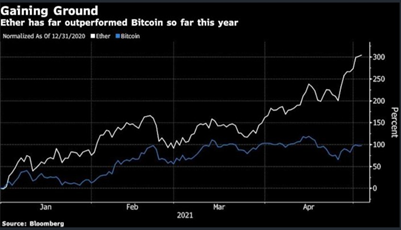
How Ethereum works
Launched on July 30, 2015, Ethereum is a decentralized exchange protocol that allows users to set up smart contracts. These are pre-established contracts, or applications that self-execute without the intervention of a third party to ensure authenticity.
For example, with Ethereum allows one to establish a future contract whereby one decides to buy an asset only when certain conditions are met. Normally, this kind of contract requires the involvement of an intermediary (a notary, etc.) and therefore extra costs and rent seeking behavior.
The Ethereum protocol allows the verification and enforcement of a mutual contract between parties on blockchain. This protocol allows developers to create applications, store records and transfer funds according to past instructions, etc.
Since 2017, hundreds of various companies (payment services, buying and selling, etc.) have developed their smart contracts and most often use the Ethereum protocol as well as ETH tokens as a means of settlement for these smart contracts.
Transactions on the Ethereum blockchain reached a record level of 41.7 million in April.
Ethereum 2.0 transition anticipation
The Ethereum blockchain incorporates several principles introduced by Bitcoin, including "mining." Contrary to the deflationary thinking behind Bitcoin's money creation, there is no limit to the amount of money that can be mined in Ethereum. But just as with Bitcoin, the network is configured so that the difficulty of mining is constantly adjusted to the computing power of the mining community.
Ethereum's growing success with the public has attracted an increasing number of new miners. The repercussion of this craze is an increase in the difficulty of mining, which can eventually discourage independent miners for whom Ether will no longer be a profitable crypto-currency.
To avoid a surge in the difficulty of mining, updates will be planned. This was the case in 2018 with a new version of the software called Serenity. This new version - Ethereum 2.0 - is a multi-step process and creates a change in the mining process from Proof-of-Work to a Proof-of-Stake mining process.
The process towards Ethereum 2.0 is underway, with the "Berlin" stage taking place on April 15. These upgrades limit the power consumption of the Ethereum network, reduce fees and the amount of ETH miners receive, which de facto reduces the selling pressure of the ETH cryptocurrency.
But the next stage "London" (EIP-1559) - will involve even more significant changes around the economic logic of Ethereum. Indeed, the protocol continues its transition from a cryptocurrency (like bitcoin) to a crypto-asset where part of the revenue from network usage is used to "burn" part of the ether supply. Eventually, the reduction in supply could become greater than the inflation of ETH (i.e. the increase in supply).
This is a fundamental change. Until now, the market's perception has been that Bitcoin's supply is limited in time, while Ethereum's is unlimited. But eventually, Ethereum may even see its supply fall (see chart below). This is a very attractive equation for investors: the growing success of the Ethereum protocol will not only increase demand but also reduce supply - the perfect "scissor effect". A development that should encourage more investors to "hodl" ETH.
Changing Ethereum economics with EIP-1559
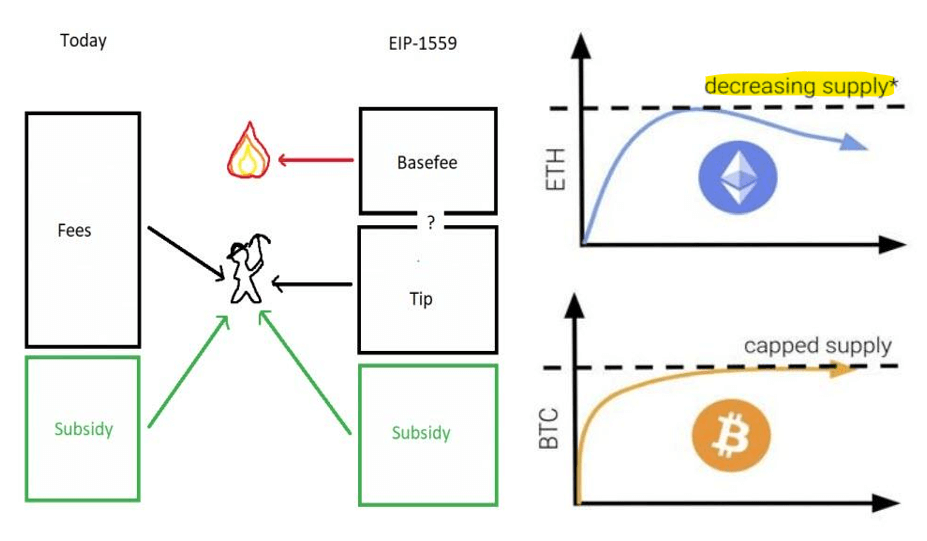
Growing popularity of DeFi benefits Ethereum
Another reason for the recent price surge is two-fold: first, there is a growing retail interest and knowledge of DeFi products, and secondly, there could be a shift from lesser performing Bitcoin towards higher performing Ether. As shown below, there is a tremendous amount of value locked in DeFi and because Ethereum is the main developer ground for these products, it could benefit from its first mover advantage. Applications developed on Ethereum generate 3X the fees for the Ethereum network as compared to Bitcoin, despite Bitcoin showing 3X the market cap.
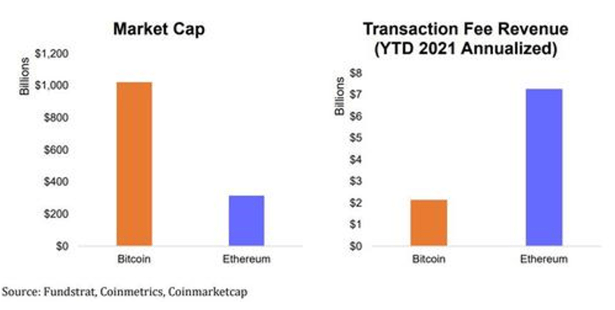
As the popularity continues growing for Ethereum, so will ETH’s price, which is one hypothesis for why some analysts predict a $10,500 price target for Ethereum. In fact, some estimates go North of $30,000 based on the premise that compared to cloud stocks, Ethereum has a higher revenue multiple and growth rate, making it look ‘’cheap’’ from an annualized revenue standpoint.
The graph below shows you how large FinTech players begin to make way for their decentralized equivalents, and in thus doing will unlock tremendous value. Today, the DeFi total value locked is $123B. This type of threat will force older companies to either build their own blockchain solutions, or more likely, connect to platform like Ethereum to stay ahead.
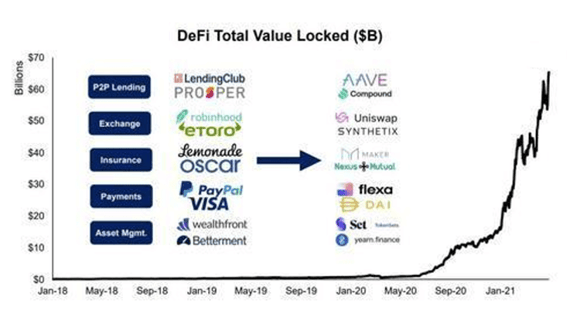
Another favorable development for the Ethereum protocol is the exponential growth of NFTs (Non-Fungible Tokens). Many NFT projects such as CryptoPunks or Decentraland have their "smart contracts" on the Ethereum blockchain.
This last figure shows a mounting reversal from Bitcoin to Ethereum—the earlier mentioned increasing ratio from a falling BTC relative to ETH. We are seeing ETH at its strongest relative position to BTC since August 2018
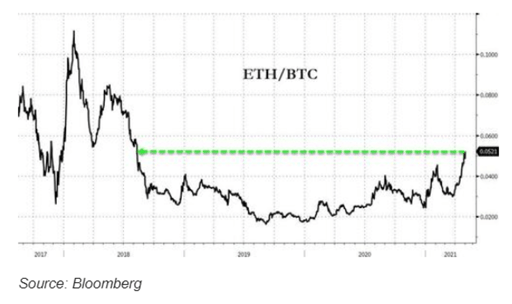
Institutional interest soars for Ethereum
The Ethereum blockchain is gaining traction as its role in the decentralized finance revolution is both crucial and becoming more well-known. So much so in fact, that late last week, the European Investment Bank decided to spearhead market developments in the digitalization of capital markets via Ethereum (things like fixed income i.e., bonds and loans with a maturity greater than 1 year).
The bank issued a EUR 100M bond via the Ethereum blockchain which represents the market’s first multi-dealer led, primary issuance of a digitally native token using an open source blockchain technology. The EIB’s reasons for this move include better market transparency, faster settlement speeds and a reduction of intermediaries and fixed costs.
Although many governments are still skeptical about crypto-currencies, some forward-thinking governments have already entered the market by favoring Ethereum. For example, the National Research Council of Canada is using Ethereum for the execution of certain public contracts. Switzerland, for its part, has allowed administrative tasks to be carried out via the Ethereum network in the canton of Zug.
This type of use case suggests the agility and adaptability Ethereum has over Bitcoin, which could sidestep the reservations investors have with regards to entering the world of DeFi. Soon, more banks could leverage Ethereum, and offload their assets on the platform, or develop smart contracts to facilitate more trades.
Ethereum valuation explained
Ether is the second largest cryptocurrency in terms of capitalization (behind bitcoin) with a market value close to $400 billion at the beginning of 2021, a capitalization greater than Bank of America or Nestlé.
For many observers, the dizzying performance of Ether and such a level of capitalization for a crypto-currency is absurd.
The company Fundstrat has tried to relate these figures to the expected sales on this protocol. As the table below shows, despite the dramatic price increase in just over 3 months, Ethereum's valuation multiples (Price to Sales, Price to Sales / Sales Growth) are no higher today than they were back then.
Ethereum valuation ratios between January and the end of April 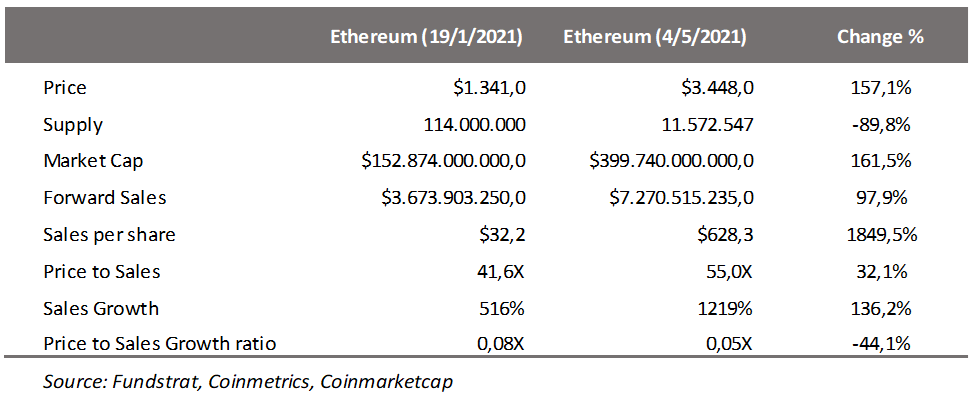
The same analyst also made a comparison between the multiples of Ether and those of software companies active on the Cloud. We see below that the multiples of these stocks (the dots on the left) vary between 5x and more than 80x. But the expected growth of their sales is in no way comparable to that of the Ether. FundStart's analyst sees Ethereum as the equivalent of Cloud 2.0 and therefore recommends positioning yourself in Ethereum from this perspective, with a price target of over $10,000...
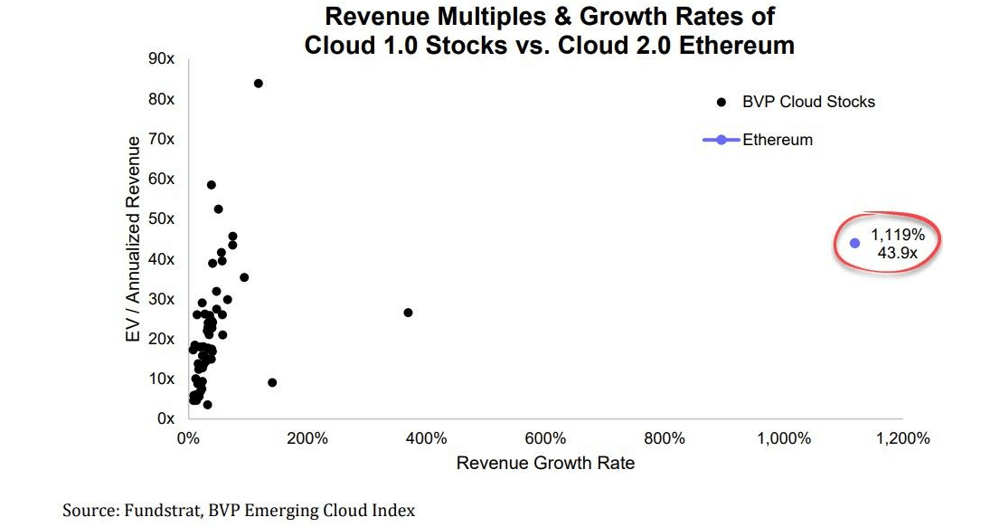
How to play a soaring ETH
It is possible to play Ethereum on FlowBank with products tailored around Ether. AETH: 21Shares Ethereum ETP, AETHEUR: 21Shares Ethereum ETP(EUR), and COINETHE: Ether Tracked One – EUR. These products track the perform of Ethereum without you directly owning an address. The conclusion to the recent developments includes a ramping up in institutional interest of the Ethereum platform, an increasing awareness and scalability of the decentralized platform and perhaps a rotation from Bitcoin into Ethereum.





